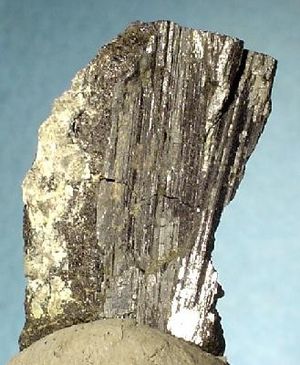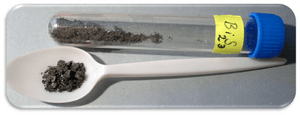Bismuth(III) sulfide facts for kids
Bismuth(III) sulfide, also known as bismuth sulfide, is a special chemical compound. Its chemical formula is Bi2S3. This means it is made of two bismuth atoms and three sulfur atoms joined together. The bismuth in this compound has a +3 oxidation state, which describes how it shares electrons with other atoms.
What is Bismuth Sulfide Like?
Bismuth(III) sulfide is a brown solid. It does not dissolve in water, which means it won't disappear if you put it in a glass of water. Scientists can make this compound in a lab. They do this by mixing hydrogen sulfide gas with another bismuth compound, like bismuth(III) chloride.
Where Can We Find Bismuth Sulfide?
In nature, bismuth(III) sulfide is found as a mineral called bismuthinite. This mineral can look lead-gray or tin-white. Sometimes, it has a rainbow-like shine on its surface, which is called an iridescent tarnish. Bismuthinite is very important because it is a main ore of bismuth. An ore is a rock or mineral from which a metal can be taken out.
Bismuthinite has a shiny, metallic color. It was first discovered in Bolivia, a country in South America. This mineral is quite heavy for its size. Its specific gravity is about 6.8. This means it is almost seven times denser than water.
Related pages
See also
 In Spanish: Sulfuro de bismuto(III) para niños
In Spanish: Sulfuro de bismuto(III) para niños



